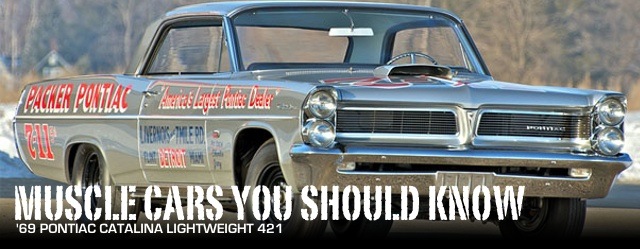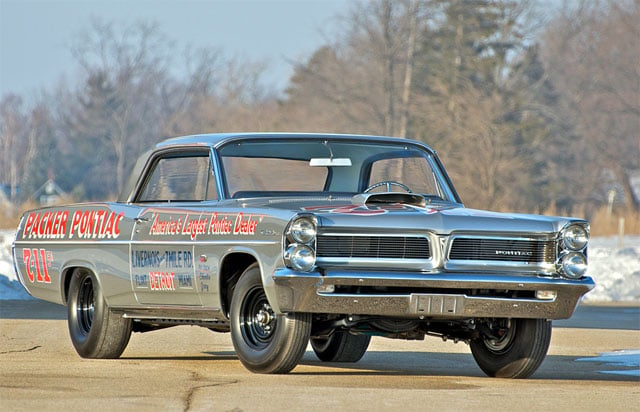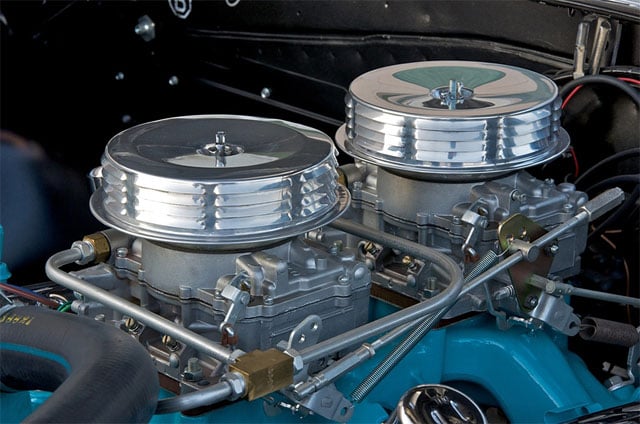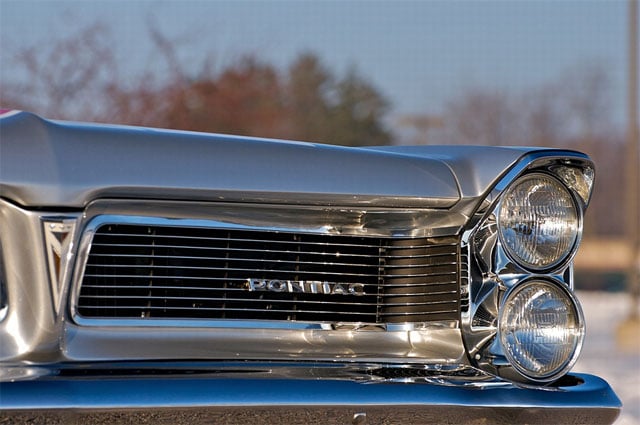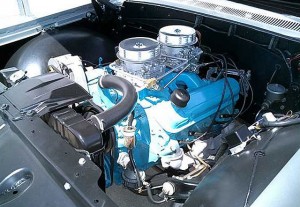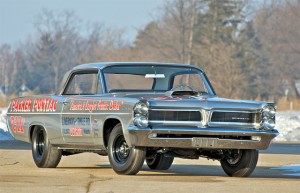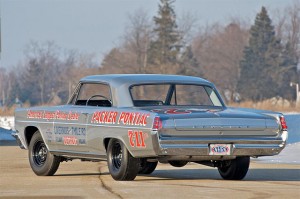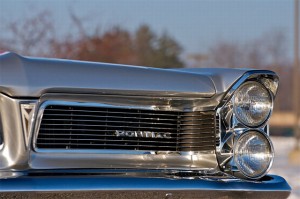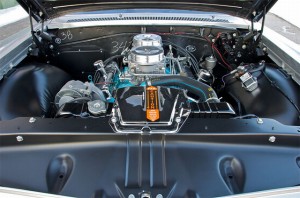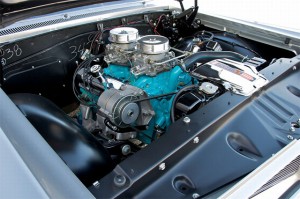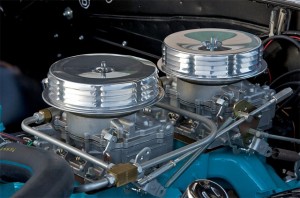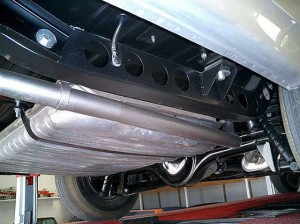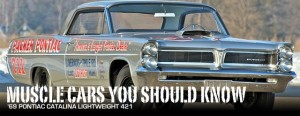Pontiac’s dominance in the early 1960’s came largely as a result of GM hiring Bunkie Knudsen in 1956. Given a five year mandate to revitalize the division, it was Pontiac’s “last chance.” Hampered by styling cycles that would not return to Pontiac for two more years, Knudsen turned to performance as a way to distinguish the division. By 1957, a bored and stroked 347cid V8 was churning out 270hp, improving 0-to-60 mph times by up to three seconds. Improved cylinder heads with a focus on improved breathing were key to the effort.
With that, Knudsen took Pontiac racing. Daytona’s Speed Weeks ended up virtually belonging to Pontiac – both in the flying mile competitions and the Grand National stock car race. Knudsen continued pushing the envelope, both in the engine labs and when the styling resources he so desperately needed became available. Thee years into his mission, Pontiac debuted new models that forever changed the public’s perception. In 1959, the Pontiac V8’s had grown to 389cid, and by increasing the compression ratio to 10.2:1, Knudsen had an engine that put out an amazing 315 horsepower.
Two defining attributes that stayed with Pontiac ever since then were the split front grille and the “wide track” stance of its cars. These were carried through the model line, from the smallest to the largest Pontiac and the message was the same to every customer: Pontiac was young America’s performance car. Knudsen continued to push the racing aspects of Pontiac’s performance, particularly in the NASCAR venues, where people could see “their” car beating Ford and Chevrolet entrants on many weekends. Drag racing had become popular as well, prompting additional resources and new thinking to be applied to winning on 1/4-mile tracks around the country.
The Pontiac Catalina was the least expensive and lightest of the full-sized coupes, following its downsizing in 1961. A two hundred pound weight savings, along with the then-legendary 389 introduced a few years earlier, made the Catalina a favorite with NHRA drag racers. In addition to engine options ranging from 267 to 363hp, Pontiac offered more esoteric choices, which included aluminum front bumpers, radiators and body parts.
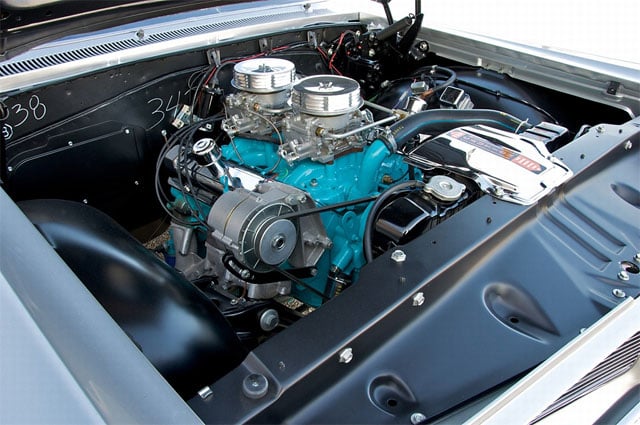
The 1962 Super Duty 421 was officially rated at 405 hp @ 5600 rpm, but true output was rumored to be closer to 460 bhp.
That year, Pontiac also applied the 389 Super Duty hardware to about a dozen 421cid V8s intended for drag strip duty. When NHRA changed the rules in 1962, the Super Duty 421 became officially listed as an expensive, limited option on full-sized production Pontiacs. The 1962 Super Duty 421 was officially rated at 405hp @ 5600 rpm, but true output was rumored to be closer to 460hp. Torque was rated as 425 ft lbs @ 4400 rpm. The cast iron block sported four-bolt mains, forged rods and crankshaft, solid lifters and NASCAR cylinder heads; there can be little doubt about the original design mandate for this engine.
Performance innovations were not just coming out of Pontiac, however. NHRA Super Stock competition was being closely contested by Ford, Chevrolet and Chrysler. To stay competitive in the 1963 season, the time had come to pull out all the stops in weight reduction. This began by cutting out the top part of the Catalina’s boxed frame rails, leaving a U-shape instead. To lighten the frame further, rather large holes were drilled into the side rails earning the nickname “Swiss Cheese” to the lightweight car.
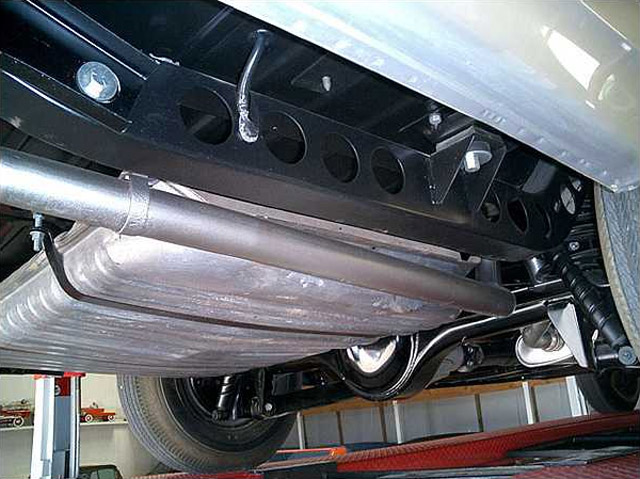
The top of the frame rails were removed, leaving a U-shaped channel, and then holes were used to lighten it further.
That was only the beginning, though. Other weight reductions were found by removing the front sway bar, substituting an aluminum bellhousing, deleting all insulation and sound deadening, and making even further use of aluminum body parts. Even the rear axle third member was replaced with an aluminum version. Optional acrylic windows could be had, along with special aluminum exhaust manifolds. These were for racing use only, as they tended to melt on extended use.
To increase the 421 engine’s output, the shortblock was upgraded with HD rotating components, as well as Mickey Thompson pistons and a McKellar solid lifter camshaft. Compression was pumped up to 13:1 and the cylinder heads reworked with dual valve springs and lightweight valves. A lightweight flywheel, aluminum intake manifold and dual Carter AFB carbs topped out the recipe that delivered an under-rated 410hp to the driver. The cumulative effect of the weight saving efforts was significant, bringing the full size car from around 3700 pounds down to just a bit over 3300 pounds shipping weight.
Mickey Thompson took delivery of the first two Lightweight Catalinas. The first served as a promotional display car and backup, while the second was run in regular competition. The promo car never saw competition in Thompson’s hands, but M/T driver Jess Tyree is known to have used it with some enthusiasm for many projects at Mickey Thompson Enterprises. The cars were sold by Thompson, along with the rest of his Pontiac inventory, after GM announced its corporate ban on racing involvement.
Before GM’s ban on racing took effect in 1963, fourteen Lightweight Catalina 421 racers were built. The example shown here was driven by Howard Maselles, an employee of Packer Pontiac of Detroit, MI. Maselles used it to set an NHRA C/Stock class record of 12.27 seconds at 114.64 mph – a record that stood for a number of years. Later, the car was sold and campaigned nationally out of Royal Pontiac in Royal Oak, MI, winning its class in the U.S. Nationals.

Only 14 of these Lightweight Catalina 421 cars were built before the GM ban on racing came into effect.
Owned by Pontiac collector and historian Randy Williams, and working with Scott Tiemann of Supercar Specialties, this particular car was restored in 2000. This Catalina Lightweight 421 has previously been offered at auction, but did not sell despite a high bid of $475,000.
Other top Pontiac drivers of the day would find themselves in the all-out Catalinas. Arlen Vanke, from Knafel Pontiac in Akron, OH, set a track record at Quaker City Dragway posting a run of 12.26 seconds at 115.78 mph in the Lightweight Catalina known as “Tin Indian III.”
Another Lightweight Catalina, prepared by Ace Wilson’s Royal Pontiac out of Royal Oak, MI, and driven by Pontiac marketing guru Jim Wangers, took Detroit Dragway by storm with a 12.38 second run, hitting 116.23 mph at the big end. Wangers had been the Pontiac liaison to Royal since 1959, and driving for Royal for several years, but his role in Pontiac history would eventually grow to more than just winning the Stock Eliminator class at the 1960 U.S. Nationals.
GM’s factory racing programs were terminated in 1963. Corporate edicts, however, could not extinguish the spark that high performance cars evoked within the Pontiac Division. It was about that time when Pontiac engineer Russell Gee figured out that the 389 cid V8 from the production Catalina could be dropped directly into place, where the mid-size cars had been designed for a 326cid V8. With that insight and a little help from his friends, a new Pontiac “Super Tempest” wasn’t far away. But, that’s another story…
CHECK OUT OTHER MUSCLE CARS YOU SHOULD KNOW
- ’69 Mercury Cougar BOSS 429
- ’69 Royal Bobcat Pontiac GTO Ram Air V
- ’87 Buick Regal GNX
- ’69 Ford Mustang BOSS 302 George Follmer’s #16
- ’69 Ford Mustang BOSS 429
- ’69 Dodge Charger Daytona #88
- ’69 Motion Chevrolet Camaro Z/28 427 ZLX
- ’69 Motion Hurst/Oldsmobile 455


